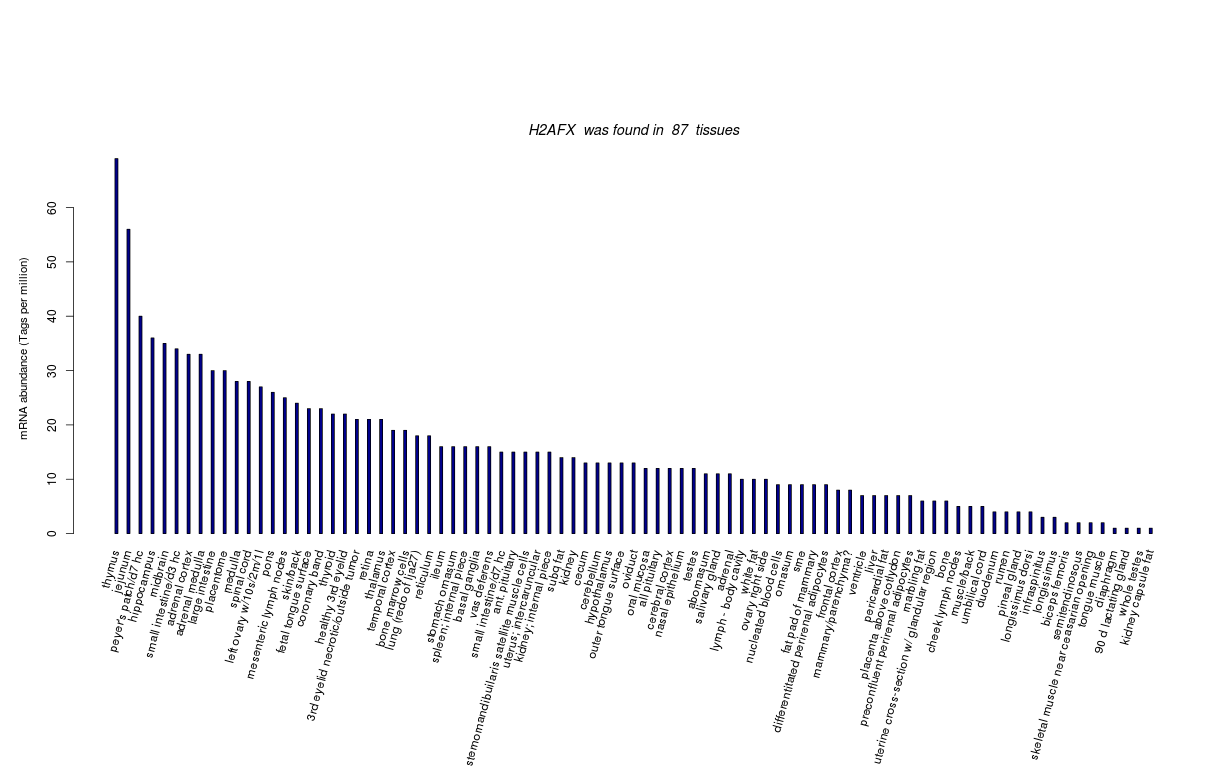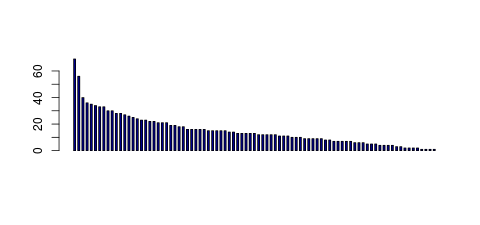| Bos taurus Gene: H2AFX | |||||||||||||||||||||||||
|---|---|---|---|---|---|---|---|---|---|---|---|---|---|---|---|---|---|---|---|---|---|---|---|---|---|
| Summary | |||||||||||||||||||||||||
| InnateDB Gene | IDBG-647424.3 | ||||||||||||||||||||||||
| Last Modified | 2014-10-13 [Report errors or provide feedback] | ||||||||||||||||||||||||
| Gene Symbol | H2AFX | ||||||||||||||||||||||||
| Gene Name | histone H2A.x | ||||||||||||||||||||||||
| Synonyms | |||||||||||||||||||||||||
| Species | Bos taurus | ||||||||||||||||||||||||
| Ensembl Gene | ENSBTAG00000038047 | ||||||||||||||||||||||||
| Encoded Proteins |
H2A histone family, member X
|
||||||||||||||||||||||||
| Protein Structure | |||||||||||||||||||||||||
| Useful resources | Stemformatics EHFPI ImmGen | ||||||||||||||||||||||||
| Entrez Gene | |||||||||||||||||||||||||
| Summary |
This gene does not have any Entrez summary - the following is the summary from its human ortholog ENSG00000188486:
Histones are basic nuclear proteins that are responsible for the nucleosome structure of the chromosomal fiber in eukaryotes. Two molecules of each of the four core histones (H2A, H2B, H3, and H4) form an octamer, around which approximately 146 bp of DNA is wrapped in repeating units, called nucleosomes. The linker histone, H1, interacts with linker DNA between nucleosomes and functions in the compaction of chromatin into higher order structures. This gene encodes a member of the histone H2A family, and generates two transcripts through the use of the conserved stem-loop termination motif, and the polyA addition motif. [provided by RefSeq, Jul 2008] |
||||||||||||||||||||||||
| Gene Information | |||||||||||||||||||||||||
| Type | Protein coding | ||||||||||||||||||||||||
| Genomic Location | Chromosome 15:30202578-30203886 | ||||||||||||||||||||||||
| Strand | Reverse strand | ||||||||||||||||||||||||
| Band | |||||||||||||||||||||||||
| Transcripts |
|
||||||||||||||||||||||||
| Interactions | |||||||||||||||||||||||||
| Number of Interactions |
This gene and/or its encoded proteins are associated with 0 experimentally validated interaction(s) in this database.
They are also associated with 207 interaction(s) predicted by orthology.
|
||||||||||||||||||||||||
| Gene Ontology | |||||||||||||||||||||||||
Molecular Function |
|
||||||||||||||||||||||||
| Biological Process |
|
||||||||||||||||||||||||
| Cellular Component |
|
||||||||||||||||||||||||
| Orthologs | |||||||||||||||||||||||||
|
Species
Homo sapiens
Mus musculus
|
Gene ID
Gene Order
|
||||||||||||||||||||||||
| Pathway Predictions based on Human Orthology Data | |||||||||||||||||||||||||
| NETPATH | |||||||||||||||||||||||||
| REACTOME |
Meiotic synapsis pathway
Deposition of new CENPA-containing nucleosomes at the centromere pathway
Packaging Of Telomere Ends pathway
Amyloids pathway
RNA Polymerase I Chain Elongation pathway
RNA Polymerase I Promoter Opening pathway
Assembly of the RAD50-MRE11-NBS1 complex at DNA double-strand breaks pathway
MRN complex relocalizes to nuclear foci pathway
Recruitment of repair and signaling proteins to double-strand breaks pathway
ATM mediated phosphorylation of repair proteins pathway
ATM mediated response to DNA double-strand break pathway
Meiotic recombination pathway
Cellular responses to stress pathway
PRC2 methylates histones and DNA pathway
misspliced LRP5 mutants have enhanced beta-catenin-dependent signaling pathway
RNA Polymerase I Transcription pathway
Signaling by WNT in cancer pathway
Homologous Recombination Repair pathway
Condensation of Prophase Chromosomes pathway
Signaling by Wnt pathway
Chromosome Maintenance pathway
Nucleosome assembly pathway
Transcriptional regulation by small RNAs pathway
Epigenetic regulation of gene expression pathway
RNA Polymerase I Promoter Clearance pathway
NoRC negatively regulates rRNA expression pathway
Telomere Maintenance pathway
Signal Transduction pathway
SIRT1 negatively regulates rRNA Expression pathway
Double-Strand Break Repair pathway
Cell Cycle pathway
DNA Damage/Telomere Stress Induced Senescence pathway
DNA methylation pathway
M Phase pathway
Cellular Senescence pathway
TCF dependent signaling in response to WNT pathway
Chromatin organization pathway
Mitotic Prophase pathway
RMTs methylate histone arginines pathway
Chromatin modifying enzymes pathway
Homologous recombination repair of replication-independent double-strand breaks pathway
Cell Cycle, Mitotic pathway
RNF mutants show enhanced WNT signaling and proliferation pathway
formation of the beta-catenin:TCF transactivating complex pathway
RNA Polymerase I, RNA Polymerase III, and Mitochondrial Transcription pathway
Senescence-Associated Secretory Phenotype (SASP) pathway
Meiosis pathway
XAV939 inhibits tankyrase, stabilizing AXIN pathway
Oxidative Stress Induced Senescence pathway
Gene Expression pathway
Disease pathway
DNA Repair pathway
Negative epigenetic regulation of rRNA expression pathway
Regulatory RNA pathways pathway
Meiotic Recombination pathway
Meiotic Synapsis pathway
ATM mediated phosphorylation of repair proteins pathway
RNA Polymerase I Transcription pathway
Oxidative Stress Induced Senescence pathway
RNA Polymerase I, RNA Polymerase III, and Mitochondrial Transcription pathway
Mus musculus biological processes pathway
Cell Cycle, Mitotic pathway
NoRC negatively regulates rRNA expression pathway
Chromatin organization pathway
Disease pathway
Chromosome Maintenance pathway
Signaling by Wnt pathway
Signaling by WNT in cancer pathway
Recruitment of repair and signaling proteins to double-strand breaks pathway
MRN complex relocalizes to nuclear foci pathway
Cellular responses to stress pathway
Amyloids pathway
RNA Polymerase I Promoter Opening pathway
DNA Damage/Telomere Stress Induced Senescence pathway
Double-Strand Break Repair pathway
PRC2 methylates histones and DNA pathway
Meiotic synapsis pathway
Telomere Maintenance pathway
Cell Cycle pathway
Assembly of the RAD50-MRE11-NBS1 complex at DNA double-strand breaks pathway
NoRC negatively regulates rRNA expression pathway
M Phase pathway
Condensation of Prophase Chromosomes pathway
Chromatin modifying enzymes pathway
DNA Repair pathway
formation of the beta-catenin:TCF transactivating complex pathway
Cellular Senescence pathway
misspliced LRP5 mutants have enhanced beta-catenin-dependent signaling pathway
RNF mutants show enhanced WNT signaling and proliferation pathway
Epigenetic regulation of gene expression pathway
Transcriptional regulation by small RNAs pathway
Packaging Of Telomere Ends pathway
TCF dependent signaling in response to WNT pathway
SIRT1 negatively regulates rRNA Expression pathway
Senescence-Associated Secretory Phenotype (SASP) pathway
Gene Expression pathway
DNA methylation pathway
Negative epigenetic regulation of rRNA expression pathway
Nucleosome assembly pathway
Deposition of new CENPA-containing nucleosomes at the centromere pathway
Regulatory RNA pathways pathway
RMTs methylate histone arginines pathway
Mitotic Prophase pathway
Signal Transduction pathway
Meiosis pathway
Meiotic recombination pathway
RNA Polymerase I Promoter Clearance pathway
RNA Polymerase I Chain Elongation pathway
Homologous Recombination Repair pathway
ATM mediated response to DNA double-strand break pathway
XAV939 inhibits tankyrase, stabilizing AXIN pathway
Homologous recombination repair of replication-independent double-strand breaks pathway
|
||||||||||||||||||||||||
| KEGG |
Systemic lupus erythematosus pathway
Systemic lupus erythematosus pathway
|
||||||||||||||||||||||||
| INOH | |||||||||||||||||||||||||
| PID NCI |
Fanconi anemia pathway
ATM pathway
|
||||||||||||||||||||||||
| Cross-References | |||||||||||||||||||||||||
| SwissProt | |||||||||||||||||||||||||
| TrEMBL | Q17QG8 Q2VT23 | ||||||||||||||||||||||||
| UniProt Splice Variant | |||||||||||||||||||||||||
| Entrez Gene | 531733 | ||||||||||||||||||||||||
| UniGene | Bt.10510 | ||||||||||||||||||||||||
| RefSeq | NM_001079780 | ||||||||||||||||||||||||
| HUGO | |||||||||||||||||||||||||
| OMIM | |||||||||||||||||||||||||
| CCDS | |||||||||||||||||||||||||
| HPRD | |||||||||||||||||||||||||
| IMGT | |||||||||||||||||||||||||
| EMBL | AY835842 BC118370 DAAA02040492 | ||||||||||||||||||||||||
| GenPept | AAI18371 AAX39431 | ||||||||||||||||||||||||
| RNA Seq Atlas | 531733 | ||||||||||||||||||||||||
| Transcript Frequencies | |||||||||||||||||||||||||
| Tag Count based mRNA-Abundances across 87 different Tissues (TPM).
Based on Data from Bovine Gene Atlas |
(Move your mouse over the image to view a more detailed version) |
||||||||||||||||||||||||


